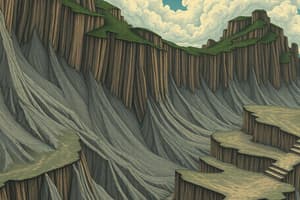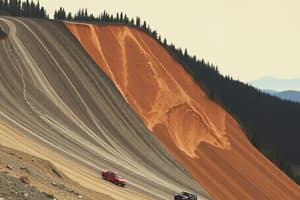Podcast
Questions and Answers
What is the main driver of landslides?
What is the main driver of landslides?
- Meteor showers
- Tidal waves
- Hurricanes
- Tectonic forces (correct)
Which factor can trigger rockfalls?
Which factor can trigger rockfalls?
- Sunlight exposure
- Snowfall
- Volcanic eruptions (correct)
- Traffic congestion
What is the distinguishing characteristic of translational landslides?
What is the distinguishing characteristic of translational landslides?
- Material shatters into small fragments
- Material falls vertically
- Material moves along a planar surface (correct)
- Material rotates around a pivot point
Which environmental condition is conducive to mudflows?
Which environmental condition is conducive to mudflows?
What type of mass movement involves a mixture of soil, rock debris, and water?
What type of mass movement involves a mixture of soil, rock debris, and water?
Which human activity can trigger landslides?
Which human activity can trigger landslides?
Study Notes
Mass Wasting: Understanding Landslides, Rockfalls, Mudflows, and Creep
Mass wasting, a geological process involving the displacement of rock, soil, or sediment from an elevated location, is a fundamental aspect of geomorphology. This process, driven by various factors such as tectonic forces, fluvial processes, or human activities, results in several sub-processes, including landslides, rockfalls, mudflows, and creep.
Landslides
Landslides, also known as mass movements, occur when a mass of rock, soil, or debris slides or falls down a slope. They are typically triggered by rainfall, earthquakes, volcanic eruptions, or human activities such as construction or mining. Landslides can be categorized into two types: rotational, where the material rotates around a pivot point, and translational, where the material moves along a planar surface.
Rockfalls
Rockfalls are a type of landslide where rocks detach from a cliff and fall to the ground. They are typically triggered by earthquakes, volcanic eruptions, or human activities such as blasting or excavation. Rockfalls can be particularly dangerous due to their sudden and unpredictable nature.
Mudflows
Mudflows, also known as debris flows or lahars, are a type of mass movement that involves a mixture of soil, rock debris, and water. They typically occur in mountainous semi-arid environments and are triggered by heavy rainfall, earthquakes, or volcanic activity. Mudflows can move quickly down a well-defined channel and can be extremely destructive.
Creep
Creep is a slow and gradual movement of soil downhill. Its velocity is usually less than a centimeter per year. Creep is driven by various factors, including freezing and thawing, and is a significant contributor to the overall erosion of the Earth's surface.
In conclusion, mass wasting is a complex and dynamic process that involves various sub-processes, including landslides, rockfalls, mudflows, and creep. Understanding these processes is crucial for predicting and mitigating the associated hazards, which can have significant impacts on human safety and infrastructure.
Studying That Suits You
Use AI to generate personalized quizzes and flashcards to suit your learning preferences.
Description
Test your knowledge about mass wasting, landslides, rockfalls, mudflows, and creep with this quiz. Learn about the causes, triggers, and characteristics of these geological processes and their significance in geomorphology and hazard assessment.




